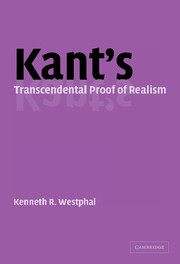Book contents
- Frontmatter
- Contents
- Acknowledgments
- List of abbreviations
- Introduction
- 1 Kant's methods: transcendental and epistemic reflection
- 2 The metaphysics of Kant's transcendental idealism
- 3 Transcendental affinity
- 4 The gap in Kant's Critique of Pure Reason
- 5 Kant's dynamic misconstructions
- 6 Kant's metaphysical proof of the Law of Inertia
- 7 Three Kantian insights
- Appendix
- Bibliography
- Index of names
- Index of subjects
6 - Kant's metaphysical proof of the Law of Inertia
Published online by Cambridge University Press: 06 November 2009
- Frontmatter
- Contents
- Acknowledgments
- List of abbreviations
- Introduction
- 1 Kant's methods: transcendental and epistemic reflection
- 2 The metaphysics of Kant's transcendental idealism
- 3 Transcendental affinity
- 4 The gap in Kant's Critique of Pure Reason
- 5 Kant's dynamic misconstructions
- 6 Kant's metaphysical proof of the Law of Inertia
- 7 Three Kantian insights
- Appendix
- Bibliography
- Index of names
- Index of subjects
Summary
INTRODUCTION
One might suggest that Kant's attempt to provide metaphysical foundations for Newtonian mechanics survives, despite problems identified in chapter 5, because his proofs of the laws of motion are independent of his metaphysical theories of matter. While Kant's proofs are to a certain extent independent of his theory of matter, close examination shows that his proof of the law of inertia is fallacious. Moreover, this fallacy extends and reinforces the problems with Kant's dynamic theory of matter. Indeed, this further fallacy shows that Kant's transcendental and metaphysical efforts to justify even commonsense causal judgments about physical events fail. This implies that causal judgments cannot be justified, legitimated, or shown a priori to be “objectively valid” by Kant's transcendental idealism. This Critical failure strongly supports and reinforces the plausibility of philosophical realism. In chapter 7 I argue that Kant's transcendental method and proof strategy provide richer resources for justifying realism and causal judgments than Kant recognized, resources that can dispense with transcendental idealism.
KANT'S PLAN FOR METAPHYSICAL FOUNDATIONS FOR NEWTONIAN PHYSICS
According to Kant's Foundations, a science, properly speaking, must be organized on rational principles (M 467–8). Any proper science has a pure rational a priori part, its metaphysical foundation (M 469–70; above, §§43, 48). After writing the Foundations (1786), Kant claims, in the second edition preface to the first Critique (1787), that his transcendental idealist account of time explains the possibility of the synthetic a priori cognitions involved in the universal theory of motion (B49, 3:59.14–16).
- Type
- Chapter
- Information
- Kant's Transcendental Proof of Realism , pp. 205 - 227Publisher: Cambridge University PressPrint publication year: 2004



